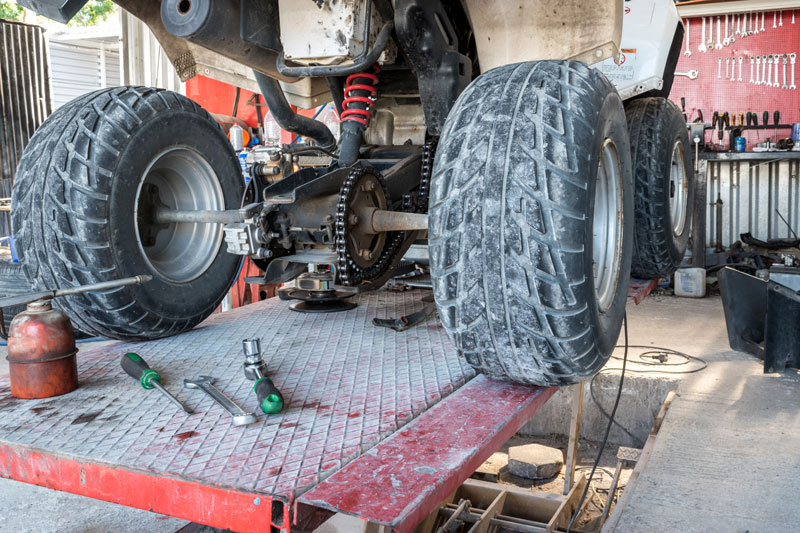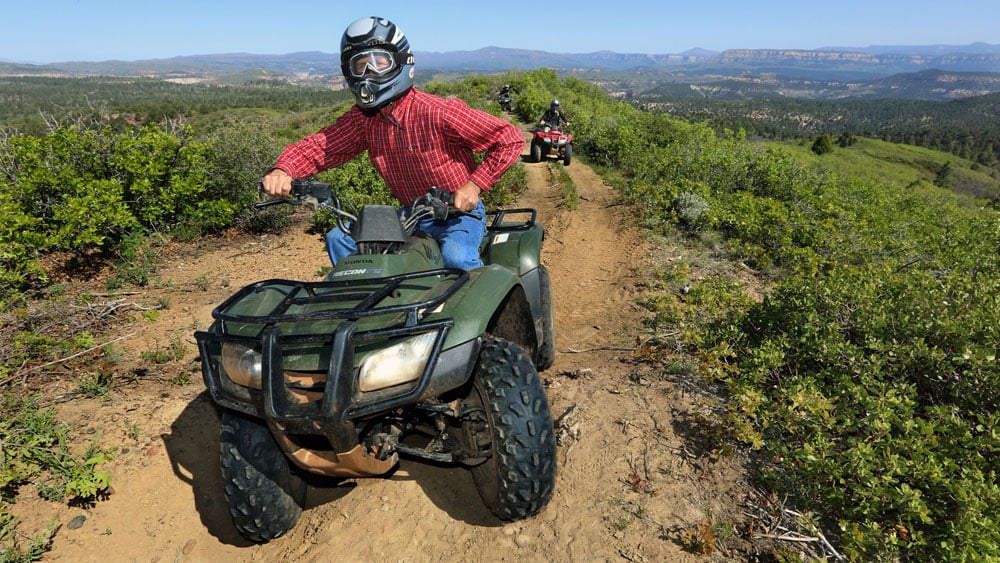Release Your Thrill-Seeking Spirit: ATV Riding Basics for every single Enthusiast
Wiki Article
ATV Riding Strategies: Mastering the Art of Off-Roading

Body Positioning
To effectively browse through difficult off-road terrain, it is critical for ATV motorcyclists to constantly maintain correct body positioning. Keeping the correct body placement while riding an ATV not only boosts control and stability but likewise ensures the motorcyclist's safety. By taking on the right body positioning methods, riders can successfully distribute their weight, enhance their equilibrium, and lessen the danger of accidents or injuries.Positioning the feet on the foot fixes enables the motorcyclist to preserve security and control over the ATV. The cyclist's knees need to be a little curved, supplying a small suspension to maintain and absorb shocks equilibrium.
Furthermore, the cyclist's eyes need to constantly be concentrated ahead, scanning the surface and preparing for any type of challenges or changes in the trail. By maintaining an onward look, bikers can make instant choices and respond suitably to challenging surface.
Throttle Control
Structure upon the value of proper body placing for ATV cyclists, grasping throttle control is a critical ability that enables cyclists to successfully steer through different off-road terrains. Strangle control refers to the capacity to regulate the quantity of power provided to the ATV's engine. By recognizing exactly how to adjust the throttle, motorcyclists can ensure a regulated and smooth acceleration, permitting them to navigate barriers with precision.Abrupt or jerky movements can trigger the ATV to lose grip or come to be unstable, making it challenging to keep control. This strategy allows the ATV to maintain a consistent rate and provides much better grip, decreasing the threat of mishaps.
In addition to smooth modulation, cyclists must likewise find out how to stabilize the throttle with various other riding techniques, such as body positioning and stopping. When climbing up steep hillsides, cyclists require to apply sufficient throttle to preserve energy without triggering or overpowering the atv wheel spin. In a similar way, when coming down high inclines, motorcyclists must use the throttle in mix with proper body positioning and braking to maintain control and protect against the ATV from moving or toppling.

Braking Strategies
A necessary element of ATV riding methods is understanding reliable stopping techniques. When it comes to off-roading, recognizing how to brake properly can make a substantial difference in your safety and control over the lorry. Among one of the most critical braking strategies is using the front brake greater than the rear brake. The front brake provides most of the stopping power, so it is critical to use it sensibly. Nevertheless, it is crucial to bear in mind that rough stopping with just the front brake can trigger the ATV to pitch ahead, possibly causing loss of control or even turning over. It is suggested to apply both brakes all at once, but with even more pressure on the front brake. One more important method is to avoid locking the wheels while stopping. Locking the wheels can lead to skidding, making it tough to keep control. To avoid this, squeeze the brake levers progressively and launch them somewhat if you feel the wheels securing. By grasping these braking methods, you can enhance your ATV riding skills and make certain a pleasurable and risk-free off-roading experience.Cornering Methods
One essential aspect of mastering ATV riding strategies is understanding efficient cornering methods. Cornering on an ATV can be challenging, yet with the appropriate strategies, cyclists can browse turns securely and effectively. The key to successful cornering is to preserve control of the ATV while making the most of traction and lessening the risk of toppling.To execute an appropriate cornering method, riders must approach the turn at a proper rate, ensuring they are not going too quick or as well slow-moving. It is important to change the body weight towards the within the turn, leaning into it to keep balance and security. This click for info assists for the centrifugal force and maintains the ATV upright.
Furthermore, bikers must keep their eyes focused on the departure point of the turn instead of the instant course ahead (ATV). This permits smoother and more exact guiding, as it helps the rider expect any barriers or changes in surface
In addition, correct throttle control plays a substantial duty in cornering. Riders should modulate the throttle efficiently, staying clear of sudden velocities or decelerations, which can create loss of control.
Uphill and Downhill Riding
When navigating off-road terrain, ATV cyclists should grasp the techniques for uphill and downhill riding to preserve control and make certain safety. Uphill riding requires a combination of balance, throttle control, and weight distribution. As riders ascend steep slopes, they ought to lean ahead to move their weight towards the front of the ATV, which boosts grip on the front wheels and avoids the car from flipping backward. ATV. Additionally, keeping a consistent throttle and avoiding sudden acceleration or slowdown aids to stop the ATV from losing momentum or obtaining stuck. Downhill riding, on the various other hand, calls for cyclists to lean back and change their weight in the direction of the rear of the ATV. This helps to keep security and stop the lorry from flipping ahead. It is vital to utilize the brakes sparingly and apply them gradually to avoid securing the wheels and blowing up. Riders must pick the path with the least barriers, as navigating downhill can be a lot more challenging due to the boosted speed and decreased grip. By grasping the strategies for uphill and downhill riding, ATV motorcyclists can confidently deal with different off-road terrains and delight in a thrilling and safe adventure.Conclusion
In verdict, mastering the art of ATV riding needs a combination of body positioning, go to my site throttle control, braking strategies, and effective cornering. Uphill and downhill riding likewise require particular skills to navigate safely. By applying these methods, bikers can improve their off-roading experience and boost their overall control and security on the ATV.ATV Riding Techniques: Understanding the Art of Off-Roading is a detailed guide that dives into the complexities of mastering the abilities required for off-road ATV riding. Whether you are a beginner or a skilled biker, ATV Riding Techniques: Mastering the Art of Off-Roading provides indispensable guidance to aid elevate your off-road ATV riding abilities to the next level.

Report this wiki page